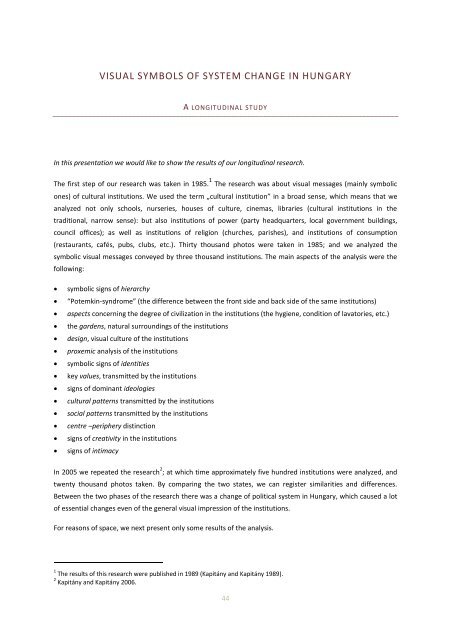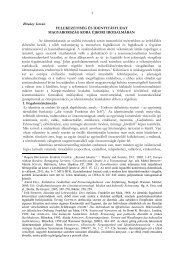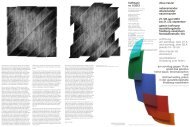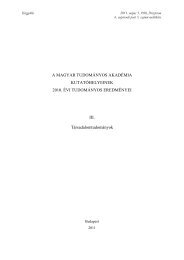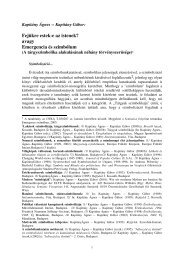symbolic elements of everyday culture - MTA Szociológiai ...
symbolic elements of everyday culture - MTA Szociológiai ...
symbolic elements of everyday culture - MTA Szociológiai ...
You also want an ePaper? Increase the reach of your titles
YUMPU automatically turns print PDFs into web optimized ePapers that Google loves.
VISUAL SYMBOLS OF SYSTEM CHANGE IN HUNGARY<br />
A LONGITUDINAL STUDY<br />
In this presentation we would like to show the results <strong>of</strong> our longitudinal research.<br />
The first step <strong>of</strong> our research was taken in 1985. 1 The research was about visual messages (mainly <strong>symbolic</strong><br />
ones) <strong>of</strong> cultural institutions. We used the term „cultural institution” in a broad sense, which means that we<br />
analyzed not only schools, nurseries, houses <strong>of</strong> <strong>culture</strong>, cinemas, libraries (cultural institutions in the<br />
traditional, narrow sense): but also institutions <strong>of</strong> power (party headquarters, local government buildings,<br />
council <strong>of</strong>fices); as well as institutions <strong>of</strong> religion (churches, parishes), and institutions <strong>of</strong> consumption<br />
(restaurants, cafés, pubs, clubs, etc.). Thirty thousand photos were taken in 1985; and we analyzed the<br />
<strong>symbolic</strong> visual messages conveyed by three thousand institutions. The main aspects <strong>of</strong> the analysis were the<br />
following:<br />
<strong>symbolic</strong> signs <strong>of</strong> hierarchy<br />
“Potemkin-syndrome” (the difference between the front side and back side <strong>of</strong> the same institutions)<br />
aspects concerning the degree <strong>of</strong> civilization in the institutions (the hygiene, condition <strong>of</strong> lavatories, etc.)<br />
the gardens, natural surroundings <strong>of</strong> the institutions<br />
design, visual <strong>culture</strong> <strong>of</strong> the institutions<br />
proxemic analysis <strong>of</strong> the institutions<br />
<strong>symbolic</strong> signs <strong>of</strong> identities<br />
key values, transmitted by the institutions<br />
signs <strong>of</strong> dominant ideologies<br />
cultural patterns transmitted by the institutions<br />
social patterns transmitted by the institutions<br />
centre –periphery distinction<br />
signs <strong>of</strong> creativity in the institutions<br />
signs <strong>of</strong> intimacy<br />
In 2005 we repeated the research 2 ; at which time approximately five hundred institutions were analyzed, and<br />
twenty thousand photos taken. By comparing the two states, we can register similarities and differences.<br />
Between the two phases <strong>of</strong> the research there was a change <strong>of</strong> political system in Hungary, which caused a lot<br />
<strong>of</strong> essential changes even <strong>of</strong> the general visual impression <strong>of</strong> the institutions.<br />
For reasons <strong>of</strong> space, we next present only some results <strong>of</strong> the analysis.<br />
1 The results <strong>of</strong> this research were published in 1989 (Kapitány and Kapitány 1989).<br />
2 Kapitány and Kapitány 2006.<br />
44


